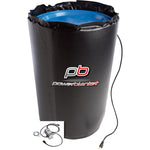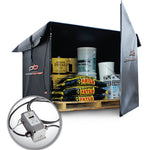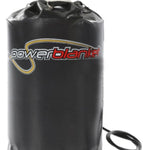You have no items in your shopping cart.
Article At-a-Glance
What Is the Best Way to Heat an IBC Tote?
The best way to heat an IBC tote is by using flexible heating jackets, such as those offered by Powerblanket and BriskHeat, which provide safe, efficient, and affordable solutions with options like adjustable temperature controllers and explosion-proof designs for hazardous locations.
Key Takeaways
- Understand the Options: Discover various IBC tote heater models, including flexible heating jackets and explosion-proof designs, tailored for different industrial needs and tote capacities.
- Evaluate Key Features: Learn about essential features such as adjustable temperature controllers, removable lids, and voltage options that ensure safe and efficient heating.
- Consider Safety Standards: Explore heaters designed for hazardous locations, adhering to both Class/Division and Zone systems, to prevent fire and explosion risks.
- Compare Leading Brands: Compare top brands like Powerblanket, BriskHeat, and ProMAX, known for their innovative solutions in industrial heating applications.
- Optimize Industrial Processes: Ensure optimal process conditions by maintaining the correct temperature for temperature-sensitive materials, enhancing safety and efficiency in your operations.
Several years ago I was speaking to a gentleman who had a 275 gallon IBC Tote Tank and was struggling to find a way to heat its contents in a cold warehouse environment. I was working at another profession at the time, and found it fascinating how he and other chemical users were heating the contents of their tanks. Some built special rooms in their building that they could heat up to high temperatures (very expensive electric bill). Others spent ridiculous amounts of money purchasing large ovens that the totes would slide into. Still, others would use dangerous heating belts and band heaters that would short out or cause fires. Working as a marketing rep at the time, I thought there must certainly be a solution to their heating needs without using risky heaters or very expensive ovens.
It was about this time I decided to make a change and pursue a career in the specialty heating industry. I found there were very few safe and affordable solutions for heating large tanks and totes. It was also about this time, Powerblanket & BriskHeat were starting to market flexible heating jackets that could wrap around these large tanks. Seemed reasonable. A light weight flexible insulated heat blanket that could wrap around the entire tank. The cost was affordable and came in different options including adjustable temperature controllers, removable lids and different voltage options. Since then, these and other companies like ProMAX have introduced a multitude of new heating products for heating everything from propane tanks, diesel exhaust fluid totes, silos, pipelines and warehouse pallets. The possibilities are endless.

An exciting development that has gotten my attention recently is the demand for explosion-proof tote heaters. Requests for intrinsically safe heaters for IBC & Stainless tote tanks is on the rise.
When electronic equipment is used in, near, or around atmospheres that have flammable gases and/or vapors, combustible dusts, flammable liquids, ignitable fibers or filings, there is always a risk or possibility that a fire and/or explosion might occur. Those areas where the possibility or risk of fire or explosion might occur due to an explosive atmosphere and/or mixture is often called a hazardous (or classified) location/area. Currently there are two systems used to classify these hazardous locations; the Class/Division system and the Zone system. The Class/Division system is used predominately in the USA and Canada, whereas the rest of the world generally uses the Zone system. The United States and Canada however, are moving more towards the Zone System. All of these developments are exciting as it allows for more and more products to be manufactured for hazardous locations.
Bottom line, heating an IBC Tote, Tank, Silo or Vessel is now a no-brainer.















